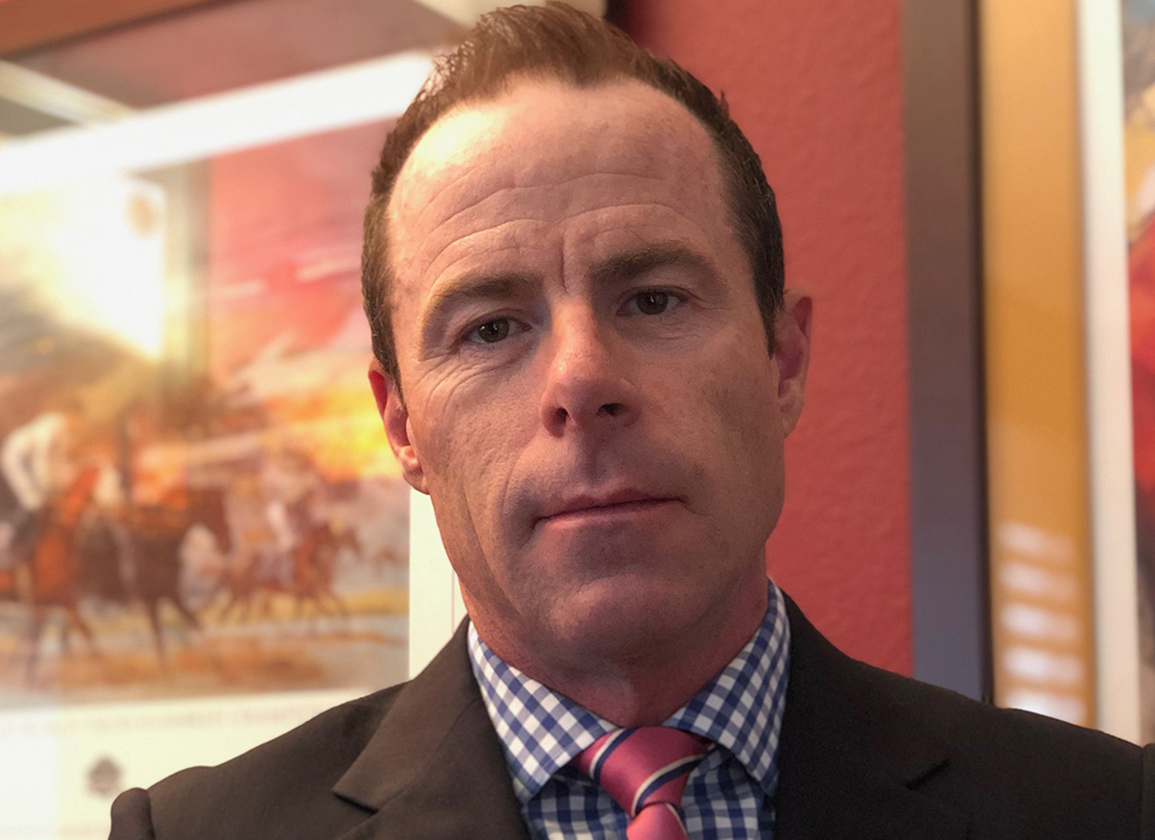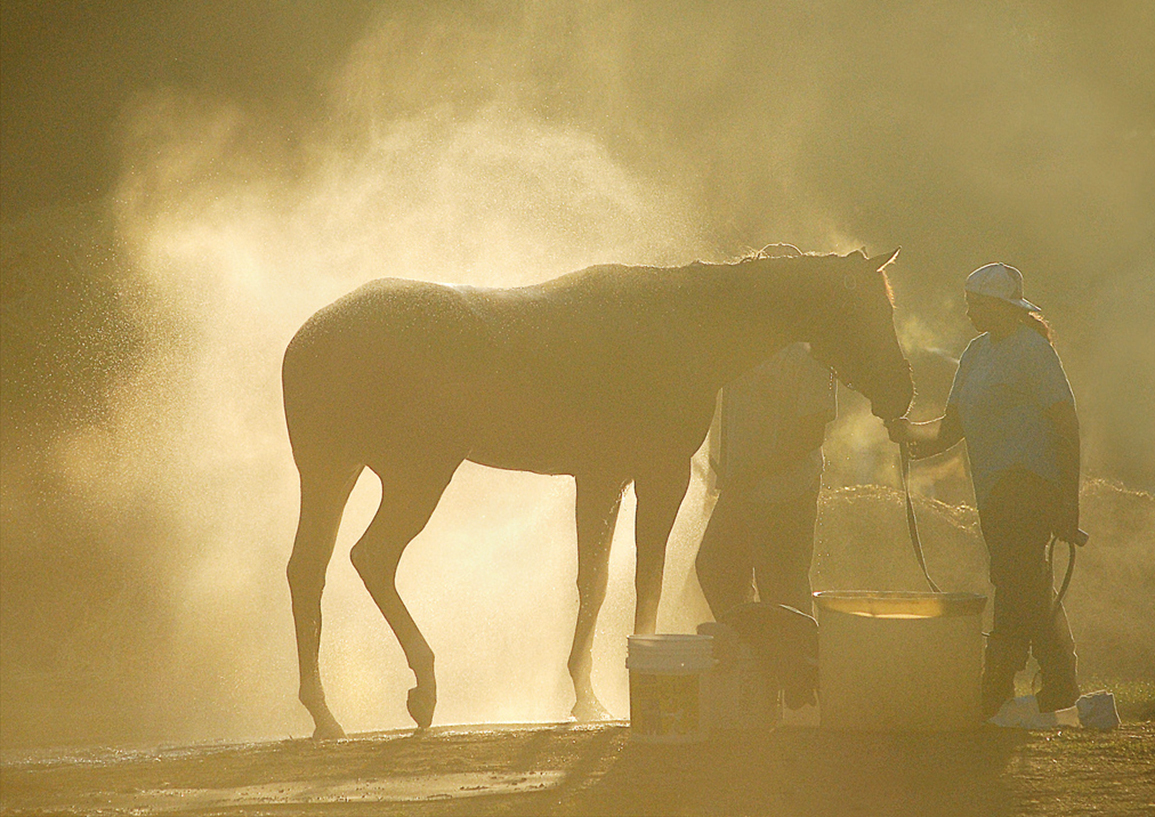Last month marked the resumption of business as usual for Jeff Blea, back as California Horse Racing Board (CHRB) equine medical director after an eight-month plus enforced hiatus due to the California Veterinary Medical Board's (VMB) controversial step of suspending his license.
In a settlement with the medical board, Blea agreed to continuing education classes in record keeping, a remittance to the VMB of $131,464 for the investigation costs, and a three-year probationary period.
Those believing the return of Blea to his prior role would bring an end to the veterinary medical board's regulatory inroads into the state's racing industry would be sorely mistaken.
The medical board has ongoing cases against at least nine other backstretch veterinarians in California, and the nature of some of the accusations–often identical in nature to those leveled against Blea–reveal a yawning schism between the veterinary board and the CHRB concerning approaches to standard equine veterinary care.
Until these differences are rectified, the legal ramifications hang like a Sword of Damocles over not just the state's racetrack practitioners but the performance horse veterinary community in general.
“It's been very unusual,” says David Foley, executive director of the American Association of Equine Practitioners (AAEP), about the nature of the complaints against Blea and some of the other backstretch veterinarians.
“If the veterinary medical board is going to interpret the rules in a companion animal manner towards equine practitioners, nobody's going to want to practice in California,” Foley says.
Areas of Conflict
The main areas of disconnect with the medical board–at least where the CHRB is concerned–surrounds the use of what the VMB terms misbranded drugs like Thyro-L, non-FDA approved compounded drugs and the correct nature of the veterinarian-patient-client relationship. More broadly, the disconnect also ensnares the prophylactic use of medications and record keeping differences between small and large animal veterinarians.
In the process, these areas highlight often conflicting sets of rules between these separate state agencies throwing the work of backstretch practitioners into confusion and possible professional jeopardy.
In short, some of the veterinarians with pending cases face a conundrum should they settle with the VMB and return to work under probation: If they then continue to practice under the CHRB's standard of equine veterinary care-but against the VMB's interpretation of the rules-they could face stark professional consequences.
The VMB deems Thyro-L, or thyroxine, misbranded under the Federal Food, Drug, and Cosmetic Act. And in laying out its accusations against some of the veterinarians, the medical board argues that the use of such misbranded drugs is prohibited through statutes written into the California Health and Safety Code.
Specifically, the code states that it is “unlawful for any person to receive in commerce any drug or device that is misbranded or to deliver or proffer for delivery any drug or device.”

Sarah Andrew
Essentially, a drug is misbranded if its labeling proves false or misleading in any particular situation, says attorney Mike Casey, who represented Blea in his case against the veterinary board. This could mean that the drug has been proven effective in the treatment of ailments for which it hasn't been labeled, says Casey, or vice versa.
But confusingly, Thyro-L is labeled for use in horses to treat hypothyroidism–a relatively rare equine condition–if dispensed by a licensed veterinarian.
Furthermore, many equine veterinarians routinely use it to treat a variety of conditions, including insulin resistance, for which there's a body of research.
“Veterinarians have a wide authority to prescribe medications,” says David Ramey, president of the Los Angeles Equine Advisory Committee, who says the VMB's stance on Thyro-L runs “absolutely contrary to regular medical practice.”
Most pertinent for backstretch veterinarians operating in California within the last decade is how the CHRB has issued advisories outlining thyroxine use in racehorses.
The first such advisory came in 2014 following an agency investigation into a series of sudden deaths among Bob Baffert-trainees, which found that the uniform use of thyroxine among the horses in question is “concerning in horses with suspected cardiac failure.”
The CHRB's much tightened rules surrounding thyroxine use went into effect earlier this year.
“If the VMB truly believed that Thyro-L was prohibited in use by the FDA as misbranded, why didn't they simply pick up the phone and call the CHRB,” says Casey. “They've been aware of the concerns surrounding Thyro-L since 2013.”
As a non-FDA approved drug, thyroxine overlaps another key area of conflict between the two agencies-the use of non-FDA approved compounded medications, which is permitted in veterinary practice in California.
So, where does the conflict arise?
Look no further than the CHRB's own Rule 1867 (b) which states that “the possession and/or use on the premises of a facility under the jurisdiction of the Board of any drug, substance or medication that has not been approved by the United States Food and Drug Administration (FDA) for use in the United States.”
The veterinary medical board appears to interpret that rule categorically, stating in complaints against several backstretch veterinarians how no compounded drugs are FDA approved, even if compounded from FDA approved parent drugs.
The list of drugs the CHRB prohibits–at least according to the veterinary board–includes commonly used compounded medications like dantrolene, used on horses that tie-up, and naquasone, which ameliorates swelling.
Crucially, the CHRB's own interpretation of its rules follows existing state law, leaving the door open to backstretch practitioners using compounded medications so long as they contain FDA-approved parent drugs.
Indeed, just last month–seemingly with this interpretive discord in mind–the agency issued an advisory to its relevant stakeholders stating that while compounded medications are not FDA approved, the CHRB's “longstanding interpretation” of rule 1867 “is that lawfully prescribed, compounded medications which are manufactured according to Federal and State guidelines do not violate this regulation.”
The advisory continues: “The CHRB recognizes that compounded medications are necessary for the safe and effective treatment of horses. These medications contain approved Federal Food and Drug Administration (F.D.A.) substances, which have been compounded to achieve proper dosages for safe and effective equine treatment and are necessary for equine veterinarians to effectively treat various medical conditions.”
Furthermore, the CHRB has never filed a complaint for violation of 1867 (b), according to CHRB spokesperson, Mike Marten.
Which leads to the final area of tension-how to define the proper veterinarian-client-patient relationship on a racetrack backstretch.
As the veterinary medical board sees it, no veterinarian can prescribe, dispense or administer a medication without first performing three main tasks: examining the patient and documenting the findings, establishing and documenting a diagnosis, then communicating the best course of treatment with the client.
Among the list of common medications that backstretch practitioners allegedly issued without first performing these tasks includes acepromazine, a tranquilizer used routinely to keep horses calm, and GarstroGard, used to treat stomach ulcers.
But backstretch practitioners and performance horse veterinarians voice frustration with what they see as the VMB's narrow interpretation of this relationship.
The problem arises, says Ramey, because the Veterinary Medicine Practice Act-the overarching rules by which all licensed veterinarians must comport their business-is almost entirely geared around small animal practice.
“The practice act doesn't really address herd health,” says Ramey, who added the American Veterinary Medicine Association (AVMA) is currently reviewing its model practice act to possibly address this. “In herd health, animals aren't always treated individually every time.”
Indeed, California's current laws are “far easier to understand and follow for small animal practitioners (who typically see individual animal patients in a brick-and-mortar context) than they are for veterinarians who treat herds, such as equine or livestock veterinarians,” wrote Dan Baxter, executive director of the California Veterinary Medical Association (CVMA), in an emailed response to questions.
Another wrinkle in the picture, say experts, concerns the currently routine prophylactic use of certain medications in performance horses to avoid injury and the onset of common training-driven ailments.
A prime example in racehorses would be the use of acepromazine-or ace, for short-used ubiquitously during morning training to keep fractious horses calm and to minimize the risk of harm to themselves and others.
“They're saying you can't give GastroGard without listening to their gut sounds and without taking their temp' and what-not on every horse every time. But not every medication requires that degree of [daily diagnosis],” says John Madigan, professor emeritus at the UC Davis school of Veterinary Medicine, calling the VMB's recent actions “horrifically wrong,” due to what he sees as those unfamiliar with equine practice leading complaint investigations.
Who Wields the Stick?
One of the main questions that arise is this: To whose rules should backstretch practitioners adhere?
The CHRB strikes the note that neither agency appears to have “primacy” of authority when it comes to regulating backstretch veterinarians. “And that's the problem because in certain areas there seems to be a disagreement about interpretation,” says CHRB executive director, Scott Chaney.
Veterinary medical board spokesperson, Monica Vargas, equivocated, writing that while the VMB “cannot advise on CHRB enforcement of laws applicable to their licensees,” the VMB has jurisdiction over the practice of veterinary medicine in California “unless otherwise pre-empted.”
Legal pre-emption, in this case, appears to come in the form of the federal Horseracing Integrity and Safety Act's (HISA) racetrack safety rules, which went into effect July 1 and provides guidelines for record keeping and appropriate veterinary-patient-client relationships.

Scott Chaney | CHRB
Indeed, “federal authority does pre-empt state law and state reg's,” says Chaney.
A HISA spokesperson told the TDN that the agency has not yet involved itself with the differences that have arisen between the VMB and CHRB.
For backstretch practitioners with cases from prior years open against them, however-along with the state's broad contingent of performance horse practitioners-HISA pre-emption is a moot point.
That's why California's equine veterinarians and leading equine veterinary bodies have been publicly sounding the alarm about the potential pitfalls of this schism since at least the January veterinary board meeting.
After that January meeting, the CVMA and other stakeholder groups asked the VMB if they could submit a presentation at the following April board meeting about their concerns. The board pulled that presentation prior to the meeting, however.
Asked why, Vargas responded that the presentation went beyond the scope of the request and included, among other things, discussion regarding pending disciplinary matters. “The Administrative Procedure Act prohibits the Board from receiving communications regarding the merits of any issue in a pending disciplinary proceeding,” wrote Vargas.
Interestingly, in a subsequent statement to its constituents, the CVMA took issue with that interpretation, writing that the VMB routinely holds policy discussions concerning the Veterinary Medical Practice Act, including while enforcement cases are simultaneously being conducted.
“If it were the case that the VMB could never talk about problematic regulations or statutes due to a risk of infringing on current disciplinary cases, then the VMB would not be able to function as a rulemaking body at all,” wrote the CVMA.
After that aborted presentation, the VMB assembled a two-person Equine Practice Subcommittee tasked with researching the equine practice regulations and statutes, taking “input” from relevant stakeholders, then “returning to the Board with particular recommendations,” wrote Vargas.
The VMB failed to answer other questions about specific goals of the subcommittee, including those about timelines and about whether the subcommittee's work could lead to amendments to the California Veterinary Medicine Practice Act.
Vargas did write, however, that at the upcoming Multidisciplinary Advisory Committee meeting this Tuesday, the Equine Practice Subcommittee will provide an “update on the issues the Board has directed the Subcommittee to research.”
One of these key stakeholders is the CVMA, which has already approached the VMB several times requesting an “in-depth look be taken at the aforementioned laws,” wrote Baxter.
“The CVMA will continue to engage the VMB in dialogue about the regulations and will strongly advocate for the veterinary profession,” Baxter added.
According to Chaney, the CHRB met with the subcommittee some two weeks ago.
The CHRB's goal for these ongoing negotiations, Chaney says, is “clarity” for licenced backstretch practitioner. “All racing veterinarians that I've spoken with want to comply with CHRB rules and vet' med' board rules, they just don't know what they are right now,” he says.
This “clarity” could come the way of changes to the California Veterinary Medicine Practice Act or to the CHRB's own regulations, says Chaney. But changes to these state rule books can be a glacially slow process.
In the meantime, backstretch practitioners with open cases against them face a Catch-22.
On the one hand, they're incentivized to settle their cases swiftly or even to defend themselves due to the VMB's right, if it prevails on any finding, to seek cost recovery, says Casey.
For Blea, that was a six-figure sum.
However, if the veterinarians settle with the VMB before these practical differences have been smoothed over, they face potentially serious consequences if they then return to active practice under a probationary period.
The VMB is “aware of that potential,” responded Chaney, when asked about this conundrum. But he was unable to elaborate on whether the VMB has proposed any timeline for resolving the agencies' differences.
Investigatory integrity
Which leads to concerns among certain stakeholders about the manner in which the VMB is conducting its investigations into California's backstretch practitioners.
According to both Casey and Blea, neither Blea nor the clients relevant to his case were interviewed as part of the investigatory process.
“At no point did anyone ever ask Jeff [Blea] what was the purpose of administering acepromazine. What was the purpose of administering aspirin powder. He was never asked at any point during the quote, investigation, end quote about anything in his medical record. Not once,” says Casey.

A busy backstretch | Sarah Andrew
“Neither were the trainers, the owners, the grooms,” Casey added. “No one.”
The TDN asked the veterinary medical board about these claims-including about standard investigatory procedures when a practitioner's veterinarian-patient-client relationship is in question-but the agency offered no response.
Other prominent figures in equine practice question the VMB's impartiality in these matters.
As someone frequently called upon to provide expert testimony in cases involving equine practice, Ramey responded to the veterinary medical board's open call for experts in Blea's case, he says.
Ramey told the TDN that when he saw the accusations against Blea, however, he spent an hour and a half explaining to two VMB attorneys that the accusations against Blea amounted to typical standards of care in horses facing rigorous training programs.
“These horses are at risk of developing certain problems, and you're trying to help mitigate that risk,” says Ramey, describing his version of the conversation with the VMB's attorneys.
“The next day they let me know that they did not need my services as an expert witness,” says Ramey, who added that he is “firmly convinced” that the VMB had a “pre-determined outcome that they were looking for.”
It should be noted that Ramey considers himself Blea's professional and personal acquaintance.
“I think it's important that the public is protected against poor veterinary practice,” he responded, when asked about how this relationship might color his opinions. “But [Blea's case] wasn't that.”
When asked about Ramey's claims, Vargas wrote that “As the adjudicator in administrative disciplinary actions, the Board does not participate in prosecutorial activity leading up to an administrative hearing. As such, the Board has no knowledge of expert witness preparation discussions for administrative hearings.”
In speaking with nearly a dozen equine practitioners or leading figures within prominent veterinary organizations, it's clear the ongoing philosophical and practical discord in equine practice has rattled the veterinary community in California.
Some veterinarians have already begun to question their professional futures in the state, says Madigan. “Unfortunately,” he adds, “a lot of veterinarians are thinking 'I just hope it doesn't happen to me.'”

The post “Horrifically Wrong”: California VMB and Equine Practitioners at Odds appeared first on TDN | Thoroughbred Daily News | Horse Racing News, Results and Video | Thoroughbred Breeding and Auctions.
Source of original post



